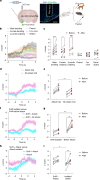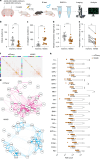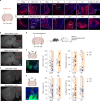A crucial role for the cortical amygdala in shaping social encounters
- PMID: 39939764
- PMCID: PMC11946885
- DOI: 10.1038/s41586-024-08540-4
A crucial role for the cortical amygdala in shaping social encounters
Abstract
Aggression is an evolutionarily conserved behaviour that controls social hierarchies and protects valuable resources. In mice, aggressive behaviour can be broken down into an appetitive phase, which involves approach and investigation, and a consummatory phase, which involves biting, kicking and wrestling1. Here, by performing an unsupervised weighted correlation network analysis on whole-brain FOS expression in mice, we identify a cluster of brain regions, including hypothalamic and amygdalar subregions and olfactory cortical regions, that are highly co-activated in male but not in female aggressors. The posterolateral cortical amygdala (COApl)-an extended olfactory structure-was found to be a hub region, on the basis of the number and strength of correlations with other regions in the cluster. Our data also show that oestrogen receptor 1 (Esr1)-expressing cells in the COApl (COAplEsr1) exhibit increased activity during attack behaviour and during bouts of investigation that precede an attack, in male mice only. Chemogenetic or optogenetic inhibition of COAplEsr1 cells in male aggressors reduces aggression and increases pro-social investigation without affecting social reward and reinforcement behaviour. We further show that COAplEsr1 projections to the ventromedial hypothalamus and central amygdala are necessary for these behaviours. Collectively, these data suggest that, in aggressive males, COAplEsr1 cells respond specifically to social stimuli, thereby enhancing their salience and promoting attack behaviour.
© 2025. The Author(s).
Conflict of interest statement
Competing interests: The authors declare no competing interests.
Figures
















Update of
-
A critical role for cortical amygdala circuitry in shaping social encounters.Res Sq [Preprint]. 2023 Jul 6:rs.3.rs-3015820. doi: 10.21203/rs.3.rs-3015820/v1. Res Sq. 2023. Update in: Nature. 2025 Mar;639(8056):1006-1015. doi: 10.1038/s41586-024-08540-4. PMID: 37461537 Free PMC article. Updated. Preprint.
References
MeSH terms
Substances
Grants and funding
LinkOut - more resources
Full Text Sources
Molecular Biology Databases
Miscellaneous

